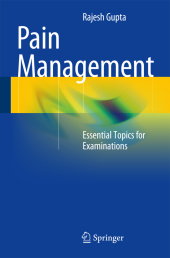 Neuerscheinungen 2014Stand: 2020-02-01 |
Schnellsuche
ISBN/Stichwort/Autor
|
Herderstraße 10
10625 Berlin
Tel.: 030 315 714 16
Fax 030 315 714 14
info@buchspektrum.de |

Rajesh Gupta
Pain Management
Essential Topics for Examinations
2014. xii, 122 S. w. 15 figs. 235 mm
Verlag/Jahr: SPRINGER, BERLIN 2014
ISBN: 3-642-55060-6 (3642550606)
Neue ISBN: 978-3-642-55060-7 (9783642550607)
Preis und Lieferzeit: Bitte klicken
Pain management is a vast subject and is changing rapidly. Finding a good resource for learning, however, is difficult. This book covers the entire curriculum relating to pain management and will make it easy to learn all aspects of the subject by covering key concepts in a reader-friendly manner. It comprises nine concise and simple chapters that aim to impart the maximum information within a limited space. These chapters address anatomy, assessment of pain, diagnosis of pain, pharmacology, non-pharmacological pain management, acute and chronic pain management, pain management in special groups, and special techniques. Pain Management: Essential Topics for Examinations will be an ideal resource for those who plan to sit for examinations, wherever they are based in the world. In addition, it will be an invaluable reference for higher and advanced pain trainees, residents, and physicians working in chronic pain.
Anatomy: Anatomy of pain pathway.- Mechanisms of pain (peripheral and central sensitisation).- Classification of pain - nociceptive, neuropathic pain.- Acute and chronic pain.- Nociceptors. Assessment of pain: Patient evaluation - history and physical examination.- Assessment and measurement of acute pain.- Assessment of chronic pain.- Assessment in elderly.- Assessment in paediatrics. Diagnosis of pain: Radiography.- Fluoroscopy.- Ultrasonography.- Nuclear medicine and PET.- CT.- MRI.- Electromyography.- Quantitative sensory testing. Pharmacology: Opioids.- Nonopioids - NSAIDs, antidepressants, anticonvulsants, sodium and calcium channel antagonists, tramadol.- Topical agents.- Alternative and herbal pharmaceuticals.- Placebo. Non pharmacological pain management: Psychological and psychosocial evaluation.- Biofeedback.- Cognitive behavioural therapy.- Functional restoration of patients with pain.- Occupational therapy.- Hypnosis.- Relaxation and imagery.- Family support.- Pain management program. Acute pain management: Post surgical pain management.- Pain management for trauma.- Labour pain management.- Burn pain.- Acute low back pain.- Patient controlled analgesia. Chronic pain management: Neuropathic pain.- Ischaemic and visceral pain.- Fibromyalgia, arthritic and myofascial pain.- Headache.- Cancer pain.- Abdominal pain.- Neck pain and whiplash injury.- Facial pain.- Neck and arm pain.- Herpes zoster and post herpetic neuralgia.- Pain following spinal cord injury.- Chronic Low back pain.- Orofacial pain.- Trigeminal pain.- Aids related pain.- Arthritis.- CRPS.- Fibromyalgia.- Peripheral neuropathy.- Sickle cell.- phantom pain.- HIV.- Pelvic pain Special groups: Paediatric.- Addiction.- Elderly Special techniques: Acupuncture.- Intrathecal drug delivery.- Botulinum toxin.- Spinal cord stimulation.- Epidural steroids.- Facet joint injections.- Radiofrequency ablation.- Peripheral nerve stimulation.- TENS.- Physiotherapy.
"The text certainly delivers on its promise of concise information covering a wide range of topics. ... This is an excellent resource for those unversed in the discipline of pain management, particularly medical students or junior residents. ... it does serve as a superb introduction with relevant information for those new to the topic." (Mehdi Sefidgar, Canadian Journal of Anesthesia, Journal canadien d´anesthésie, Vol. 62, July, 2015)
"This is a quick review of pain topics frequently found on examinations. Each topic is covered in one to two pages and the entire book can be reviewed in one sitting right before an examination. ... The primary audience is readers sitting for a pain examination but the book will also be of use to physicians at all levels of training and to physicians who see patients with chronic pain conditions. The author is an experienced clinician and examiner." (Tariq M. Malik, Doody´s Book Reviews, October, 2014)


